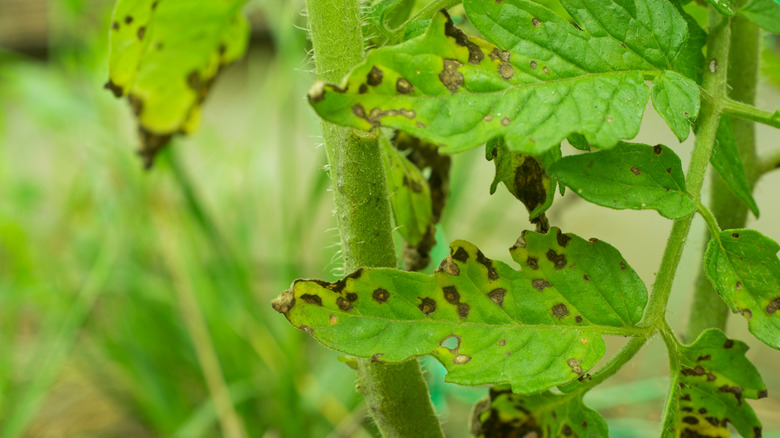
If the farm has a mix of infested and non-infested fields, work in the infested fields last, and sanitize the equipment before returning to the non-infested fields. The initial management strategy is to prevent the introduction of the pathogen by sanitizing equipment, tools, and other items on which soil can be moved before entering non-infested fields. Phytophthora diseases on watermelon can be difficult to control once the pathogen is established in the field. However, a study specifically looking at the effects of fruit age on susceptibility found that fruit are equally susceptible at all ages, and fruit rot levels were not correlated to fruit sugar content. 1,2 Some studies have reported a higher incidence of fruit rot later in the season, giving rise to speculation that older fruit may be more susceptible to infection by Phytophthora. Dispersal patterns often follow paths of water drainage in the field, usually preading along rows faster than across rows. The disease is often most severe in low-lying areas of the field, where the soils remain saturated for extended periods. Overhead irrigation, rainfall, high relative humidity, and sites with poorly drained soils all contribute to increased disease severity. 1,2ĭisease spread and development are favored by warm (77☏, 25☌) and wet conditions. Sporangia can germinate and produce hyphae that directly infect the plant, or they can release 20 to 40 swimming zoospores that can move in films of water on plant surfaces before infecting the plant, increasing the number of infections resulting from one sporangium. The pathogen is spread by the movement of spore-like structures called sporangia, mostly in splashing and flowing water. The pathogen has a wide host range, including other crop and weed species. Phytophthora spores can remain viable in the soil for over ten years. Phytophthora capsici overwinters in infested crop debris, as spores in the soil, and on the roots of some weed species. 2,3,4,5 Symptoms may develop on the crown, stems, and leaves before appearing on the fruit. Infected fruit rot rapidly, and they collapse entirely within a few days. This growth includes masses of sporangia (spore-forming structures), and the growth can completely cover the fruit under moist conditions. 2,4 The lesions are several inches in diameter and often become covered with a white fungal growth, sometimes described as having a “powdered sugar” appearance (Figure 2). Fruit infections can occur at any time from fruit set through harvest. These lesions can also develop on the upper fruit surface from inoculum splashed onto the fruit by rain or overhead irrigation. Initial symptoms include the development of water-soaked lesions. The fruit rot phase typically starts on the parts of the fruit that are in contact with the soil. Dark brown lesions sometimes develop on the leaves.

1,3 In some cases, the entire root system rots.

The leaves and stems can turn brown and die within a few days of symptom development. Leaves and stems show a sudden and permanent wilt, initially without a color change.

Initial symptoms of crown and root rot include the affected tissues becoming water-soaked, soft, and turning tan to brown to black (Figure 1). Other crop species, including tomato, pepper, and legume crops, are also hosts of P. 1,2 Phytophthora blight is more common on summer and winter squash, but almost all cucurbit crops are susceptible to the disease. Moderate to high levels of fruit rot can result in total crop loss because of the difficulty of selectively harvesting non-infected fruit.

Fruit rot attacks the harvested product directly, making the fruit non-marketable. Root rot, crown rot, and foliar blight can reduce yield potential by slowing plant growth and reducing the number of fruit produced, if not killing the plant outright. Phytophthora capsici can infect watermelon plants at any stage of development and can result in a range of symptoms. The species Phytophthora capsici is the most common cause of Phytophthora blight, but other Phytophthora species are sometimes involved. 1,2 Phytophthora belongs to the oomycete (water mold) group of fungal-like organisms. Sometimes, the term Phytophthora blight is used to refer to any of these diseases. Pathogens in the genus Phytophthora cause several diseases of watermelon, including damping-off, root rot, crown rot, foliar blight, and fruit rot. » Integrated programs using cultural and chemical control strategies can help manage Phytophthora blight on watermelon. » When severe, Phytophthora blight can result in a complete loss of fruit production and death of the plant. » Phytophthora blight of watermelon includes infections of the roots, crowns, stems, leaves, and fruit.
PHYTOPHTHORA ON TOMATOES PDF
Click here to download a PDF version of this spotlight.


 0 kommentar(er)
0 kommentar(er)
